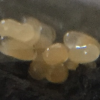Not sure this is a Queen or not...
1.caught: ~ 40 miles NE of Barstow, CA
2. time: 11 sep (today)
3. Mojave Desert: grass/sand/rock, found on a building top, seeking moisture in cracks/under some boards
4. 9-10mm
5. dark red brown
6. Gaster seems to be much lighter on the midsection, some of them even almost a light yellow. Also gaster seems to be thick at the end.
7. seem a bit lethargic, may be heat
8. nests in area seem to be typical harvester types, lots of dark red ants


















